#IndiaInfrastructure
Explore tagged Tumblr posts
Text
Beyond Concrete: Infrastructure's Ripple Effect on Indian Economy 🏗️➡️💰
India's infrastructure boom is more than just construction; it's transforming the entire economic landscape. Beyond the direct beneficiaries, this surge creates significant opportunities in interconnected sectors like cement, steel, logistics, and even financial services. Understanding these ripple effects allows retail investors to uncover diverse opportunities and strategically diversify their portfolios in India's growing market.
https://gwcindia.in/blog/beyond-construction-exploring-the-ripple-effect-of-infrastructure-development-on-related-sectors/

#IndiaInfrastructure#EconomicGrowth#SectorImpact#InvestmentOpportunities#RetailInvesting#IndianEconomy#best stock market advisor#investing stocks#best stock broker in india#best stock advisor in india#best stocks to buy#investsmart#investors#investment
0 notes
Text
ফাস্টট্যাগে বার্ষিক পাস আনার ঘোষণা নিতীন গড়কড়ির
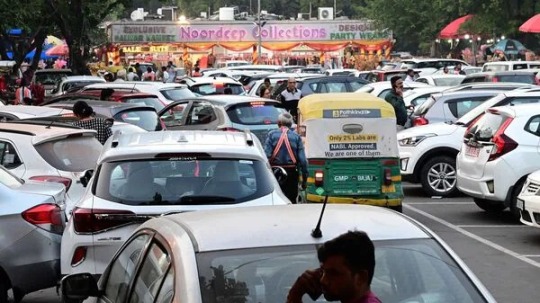
https://durantbarta.com/country/nitin-gadkari-announces-to-introduce-annual-pass-in-fastag
#NitinGadkari#FASTag#AnnualPass#FASTagUpdate#TransportNews#HighwayToll#RoadTransport#IndiaInfrastructure#GadkariAnnouncement#TollSystemIndia#durantabarta
0 notes
Text
What Makes the Delhi Mumbai Expressway India’s Smartest Highway?
The Delhi Mumbai Expressway is redefining road travel in India with its state-of-the-art infrastructure and smart technology. Spanning over 1,300 km, it features automatic toll collection, advanced traffic monitoring systems, and dedicated EV lanes—making it not just the longest but also the smartest highway in the country. Designed for speed, safety, and sustainability, it drastically cuts travel time between Delhi and Mumbai while boosting connectivity across states. With green corridors and solar-powered lighting, the Delhi Mumbai Expressway is a true symbol of India’s next-gen highway revolution.
0 notes
Text
India’s Largest Hydro Power Project: Subansiri Dam & the Crucial Role of Formwork in Its Construction
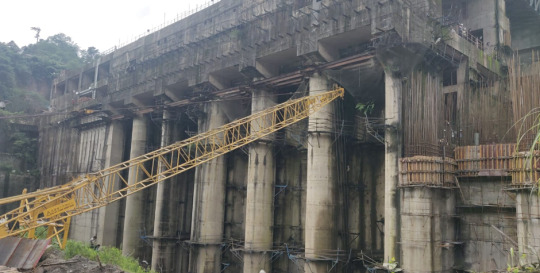
In the heart of the Eastern Himalayas, on the border between Arunachal Pradesh and Assam, stands a colossal symbol of India’s renewable energy ambitions — the Subansiri Lower Hydro Electric Project (SLHEP). Once completed, it will be India’s largest hydro power project, with an impressive capacity of 2,000 megawatts (MW).
But behind the power and scale of this engineering marvel lies a critical component that often goes unnoticed — formwork. It’s the unsung hero that shapes the dam, quite literally.
🚧 What is the Subansiri Dam?
The Subansiri Dam is a run-of-the-river hydroelectric project constructed by NHPC Limited (National Hydroelectric Power Corporation). Stretching across the Subansiri River — a major tributary of the Brahmaputra — the project is a major step toward boosting India’s clean energy supply in the northeastern region.
Project Capacity: 2,000 MW
Location: Arunachal Pradesh–Assam border
Type: Concrete gravity dam with underground power house
Significance: Will power millions of homes, reduce fossil fuel dependence, and support regional development
But how do engineers shape such a massive, high-precision structure? This is where formwork becomes indispensable.
🏗️ The Importance of Formwork in Dam Construction
Formwork is a temporary or permanent mold used to hold freshly poured concrete in place until it hardens into the desired shape and gains strength. In dam construction, especially for a project as complex as Subansiri, formwork is mission-critical.
Here’s why formwork is so vital:
Structural Precision: Large hydro structures demand extreme accuracy. Whether it's the spillway, powerhouse tunnels, or intake structures, formwork ensures the correct geometry and alignment.
Load Support: Wet concrete is extremely heavy. Formwork systems are designed to withstand immense pressure, keeping the structure stable during casting.
Speed and Efficiency: Reusable formwork modules accelerate construction and reduce project timelines — essential for high-impact projects like Subansiri.
Versatility: Dam structures are not simple boxes. They include curved walls, deep shafts, and sloped channels. Formwork can be custom-engineered to accommodate these complex designs.
✅ Key Advantages of Modern Formwork in Subansiri Dam
Let’s look at the major benefits of using efficient formwork systems in hydro power projects:
1. High Strength and Durability
Formwork components made of steel handle repetitive use and high stress, making them ideal for mega-structures.
2. Better Surface Quality
A well-designed formwork ensures smooth concrete finishes, reducing the need for extensive plastering or repairs.
3. Faster Turnaround Time
Modular formwork systems allow for quick setup and dismantling, cutting down on labor time and boosting productivity.
4. Safety First
With built-in scaffolding and access platforms, modern formwork ensures worker safety at various heights and complex work zones.
5. Eco-Friendly & Cost-Effective
Reusable formwork reduces material wastage and lowers the project’s carbon footprint. Over time, it also helps cut down costs.
6. Accommodates Innovation
From inclined spillways to underground power houses, modern formwork is adaptable to creative engineering and architectural needs.
🌱 Building a Sustainable Future with Smart Construction
Projects like the Subansiri Dam are more than just power generators—they represent a future where engineering, sustainability, and innovation intersect. And in that journey, formwork is a silent but crucial enabler. It’s not just about pouring concrete; it’s about shaping the future — one mold at a time.
📌 Conclusion
As India continues to pursue energy independence and green development, large-scale infrastructure projects like Subansiri will lead the way. And while the grandeur of dams and powerhouses grabs headlines, it’s essential to appreciate the behind-the-scenes systems — like formwork — that make such megaprojects possible.
For more details visit our website: www.teamtechengg.com and Mail us: [email protected]
TEAMTECH FORMWORK SOLUTIONS - HYDERABAD AND AJMAN
#SubansiriDam#HydroPowerIndia#IndiaInfrastructure#GreenEnergy#FormworkTechnology#ConcreteConstruction#SmartEngineering#DamConstruction#SustainableDevelopment#RenewableEnergy#CivilEngineeringIndia#ModernFormwork#HydropowerProject#CleanEnergyIndia#StructuralEngineering#NHPC#ConstructionInnovation#IndiaMegaProjects#SmartConstruction#BuildTheFuture
0 notes
Text

Need stack parking solutions in Mumbai? Gubbi Stack Parking Solution provides efficient, automated systems to maximize space in residential and commercial areas. Upgrade to smart parking today!
#StackParkingSystemInIndia#GubbiStackParking#AutomatedParking#SmartParkingIndia#VerticalParkingSystem#SpaceSavingSolutions#UrbanParking#ParkingInnovation#IndiaInfrastructure#EfficientParking
0 notes
Text

At Dholera SIR, you get options to make wise decisions about your investment. With Satyaja, we assist you in smart investment.
Visit: https://www.satyajainfratech.com/
#dholeraupdates#dholeraplots#commercialplot#dholera#indiainfrastructure#investment#infrastructureofindia#propertyforsale#realestate#reraapproved#DholeraSmartCity#DholeraSIR#smartcityindia#industrialproperty#growth#dholeraplotprice
0 notes
Text
Aluminium Formwork in India
Aluminium Formwork Companies in India provide cutting-edge solutions for fast and efficient construction. These companies offer lightweight, durable, and reusable aluminium formwork systems that ensure precision, strength, and cost-effectiveness. Ideal for residential, commercial, and infrastructure projects, aluminium formwork enhances construction speed while delivering high-quality finishes. With minimal maintenance and eco-friendly benefits, it is a preferred choice for modern builders. Leading Aluminium Formwork Companies in India focus on innovation, ensuring seamless project execution with reduced labor and material waste. Choose a trusted provider to optimize your construction process and achieve superior structural integrity. Contact us today for customized solutions!
#AluminiumFormwork#FormworkIndia#ConstructionInnovation#BuildingSolutions#IndiaInfrastructure#FormworkTechnology
0 notes
Text
youtube
Discover the impact of monsoons, poor construction, and delayed repairs on our road network. Did you know that out of India's vast 5.9 million kilometres of roads, nearly 40% are in poor condition? Even more concerning, over 30% of villages still lack all-weather road access.
#RoadSafetyIndia#IndiaInfrastructure#PoorRoadConditions#BTESConsulting#InfrastructureChallenges#BetterRoadsIndia#EngineeringSolutions#PotholeProblems#RoadMaintenance#SafeTravelIndia#SustainableDevelopment#RoadConstructionIndia#MonsoonImpact#VillageConnectivity#HelpingTheNationGrow#youtubeshorts#facts#indianroad#roads#highways#Badroads#PotHoles#Youtube
1 note
·
View note
Text
https://timesproperty.com/news/post/delhi-mumbai-expressway-delhi-stretch-set-to-open-on-nov-12-blid8676

#DelhiMumbaiExpressway#HighwayToMumbai#IndiaInfrastructure#DelhiMumbaiConnection#DelhiExpresswayLaunch
0 notes
Text
The Importance of an Underground Drainage System in India: Exploring Readymade Drainage Chambers
In India, efficient water management is critical, especially given the country's diverse climatic conditions and frequent rainfall. An underground drainage system in India plays a vital role in preventing flooding, managing stormwater, and protecting the environment. As urban areas continue to grow, the need for effective drainage solutions becomes even more pressing.

Understanding Underground Drainage Systems
An underground drainage system is designed to transport excess water away from populated areas, reducing the risk of waterlogging and ensuring the longevity of infrastructure. These systems are particularly beneficial in densely populated cities where traditional drainage solutions may be inadequate.
Advantages of Readymade Drainage Chambers
One innovative solution to enhance underground drainage is the use of readymade drainage chambers. These pre-fabricated units offer several advantages:
Cost-Effective: Readymade drainage chambers reduce labor and material costs associated with traditional drainage solutions.
Time-Saving: Installation is quick and easy, allowing for faster project completion.
Durability: Made from high-quality materials, these chambers can withstand harsh environmental conditions.
Versatility: They can be used in various applications, from residential areas to commercial developments.
Why Choose a Readymade Drainage Chamber?
When considering an underground drainage system in India, choosing readymade drainage chambers can simplify the design and installation process. These products are engineered for optimal performance, ensuring efficient water flow and minimizing maintenance needs.

Conclusion
Investing in a reliable underground drainage system is crucial for sustainable urban development in India. By opting for readymade drainage chambers, property owners and developers can ensure effective water management while saving time and resources.
#UndergroundDrainage#DrainageSystem#IndiaInfrastructure#WaterManagement#StormwaterManagement#ReadymadeChambers
0 notes
Text
How does Wagad Infra Projects handle challenges during bridge construction?
We are adept at anticipating and managing challenges during bridge construction, such as difficult terrain, unexpected weather conditions, or logistical issues. Our team is trained to quickly adapt and find innovative solutions to keep the project on track. Through careful planning and continuous communication with stakeholders, we minimize disruptions and ensure smooth project execution.
#constructionexcellence#bridgeengineering#highwayconstruction#infrastructuredevelopment#diaphragmwalls#wagadinfraprojects#concretewalls#civilengineering#construction planning#UndergroundConstruction#IndiaInfrastructure
0 notes
Text
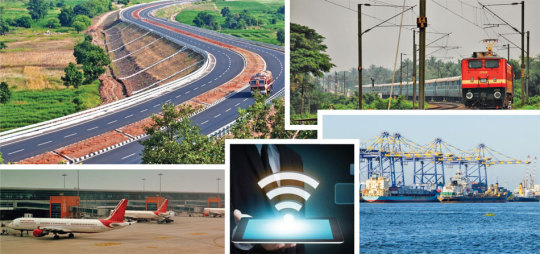
India is undergoing major improvements to its road and bridge infrastructure through several initiatives and projects. The Bharatmala Pariyojana project aims to develop 34,800 km of highways and has increased construction speed significantly. Twenty Seven greenfield expressways are also being built. Rural roads development is gaining focus with the Pradhan Mantri Gram Sadak Yojana completing over 3.5 lakh km of rural roads. Upcoming initiatives like the Sagarmala project and Gati Shakti Master Plan aim to further optimize logistics and transport. New technologies like BIM and drones are also fast tracking road surveys and design.
Overview
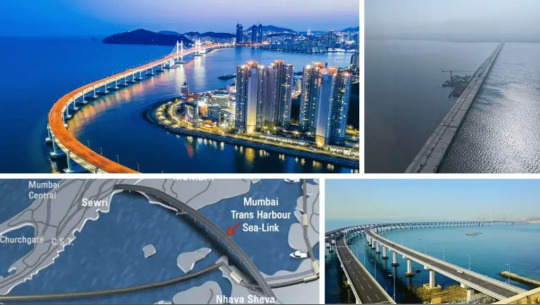
It is a matter of pride for India that the second-largest road network in the world, which is 6.37 million kilometers in length, is our possession. In the last few years, there has been a dramatic rise in the country's highway construction speed from around 12 kilometers per day in 2014-15 to around 29 kilometers per day in 2021-22. The number of functional highways has gone up from 97,830 kilometers in 2014 to 145,155 kilometers today. On the other hand, the nine years of the Pradhan Mantri Gram Sadak Yojana (PMGSY) have seen the construction of more than 3.5 lakh kilometers of rural roads which have made all-weather roads free from all-weather roads connectivity to villages of India. The government's budget allocation for road infrastructure has had a rapid increase, now amounting to about ₹1.4 lakh crore in FY22-2023. Through the completion of strategic projects like the Atal Tunnel, the Dhola-Sadiya Bridge, and the Chenab River Bridge during a relatively short time frame, the government impresses the public with its inclusive governance and readiness to connect even the remotest regions of the country.
India’s Paving Innovative Developments in Road and Bridges Infrastructure
India is involved in the execution of highly ambitious infrastructure projects like the Chenab Bridge, which is the tallest arch railway bridge and is located near one of the highest altitudes, and an Indian Railway line that runs throughout its entire length. This bridge is a demonstration of the amazing engineering skills that Indians possess and is proof that a cohesive team, as leaders, can generate solutions that will in turn sustain the development of India.
The Indian government emphasizes infrastructure development and the government has developed schemes and policies within the framework of infrastructural development. The National Infrastructure Pipeline (NIP) in 2019 is an initiative that enables governments at the national level to focus on social and infrastructure projects including energy, roads, railways, and urban development projects worth INR 102 lakh crores. The Centre and States have the next to equal share of close to 40% each and the private sector has a 21% share. NIP also takes advantage of the PM GatiShakti Master Plan, which intends to intensify India's logistics system. In the Indian Budget 2023-24, the Government of India highlighted the necessity of stepping up the amount of money spent on infrastructure and nearly tripled its infrastructure spending to 3.3% of GDP against 2019-20 expenditure. INR 75000 crores, which is a budget for 100 projects is crucial towards the development of the comprehensive multimodal logistics infrastructure.
As of the end of July 2023, Indians’ total length of national highways amounted to 146,145 km. This figure showed a 60 percent increase from the April 2014 level of 91,287 km. The government aims to achieve this by 2030 with 1.3 times more as compared to the 2020 value which makes it 185,000 km and with 1.6 times more as compared to the 2020 value it should make it 237,000 km by 2047. The Bharatmala Pariyojana, which is the nation's largest infrastructure project, envisages the development of about 34,800 km of national highways. There would be around 27,000 km of this awarded and about 14,500 km already constructed by July 2023 with a capital expenditure of Rs 10.64 trillion As well as this, the building of 27 greenfield expressways is ongoing with a capital cost of Rs 4.5 trillion. The feather in the cap, however, is the construction of the Delhi-Mumbai Expressway, Mumbai-Nagpur Samruddhi Expressway, Bangalore-Chennai Expressway, Delhi-Amritsar-Katra Expressway and the one between Kanpur and Lucknow Expressway.
The emphasis given by the central government to the road sector is vividly illustrated in the uptick of Capital spending by the Ministry of Road Transport and Highways (MoRTH), which has gone from Rs. 0.31 trillion in 2013-14 to Rs. 2.59 trillion in 2023-24, with a 23% CAGR. Out of the capex of 50,000 crore rupees provisioned for the next financial year, about 60 percent has been allocated to the National Highways Authority of India or NHAI. In the last two years, the hybrid annuity model (HAM) share with 55 percent retained in projects awarding has been followed up with the engineering, procurement, and construction (EPC) constituting 44 percent. The government focuses on contributing to the BOT model which is intended to improve the quality of projects. Through this, it aims to increase the chunk of BOT projects from the current share of less than 5 percent to around 10 percent in the coming two years.
Key Initiatives and Their Impact
Bharatmala Pariyojana: This flagship program envisions an integrated network of highways spanning the nation. The project has significantly expedited the pace of highway construction, with India achieving an average construction rate of 37 km per day in 2022-23, a remarkable increase from 12.1 km per day in 2014-15.
Sagarmala Programme: Focusing on coastal and port-led development, this initiative aims to modernize India's ports, optimize logistics efficiency, and boost maritime trade.
Gati Shakti National Master Plan: This transformative plan promotes integrated infrastructure planning and implementation. Gati Shakti utilizes technology to break down silos between various ministries, enabling seamless coordination and accelerated project delivery.
Focus on Rural Roads: The Pradhan Mantri Gram Sadak Yojana (PMGSY) has been instrumental in connecting rural habitations, providing much-needed access to essential services, markets, and opportunities for India's vast rural population.
Strategic Connectivity Projects: The construction of iconic bridges like the Chenab River Bridge (the world's highest railway bridge) and projects such as the Atal Tunnel have overcome geographical challenges, particularly in border and remote regions, thereby fostering national integration.
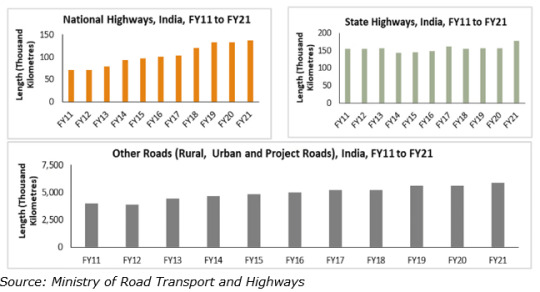
Source: Ministry of Road Transport and Highways
Upcoming Expressways Projects in India

According to the report, aided by the Pradhan Mantri Gram Sadak Yojana (PMGSY), rural road development has also gained traction, with rural roads accounting for 71 percent of the overall road network in India.
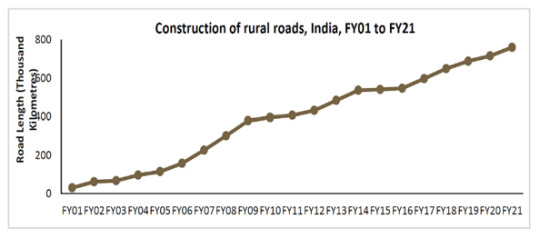
During the last decade, the Indian government’s rural road development projects have gained momentum and the authorities are currently engaged in rural road network development. This also is the case as the farmers, especially those who engage in the export market, depend on the rural roads that offer economic benefits like reducing the cost of production and time of transport.
The Ministry of Road Transport and Highways (MoRTH) targets for two hundred thousand kilometers of National Highway Network to be finished by 2025. The aim is to construct the highest quality road infrastructure with the help of a plan-oriented and result-oriented approach. This year MoRTH plans to create an all-time high of 13,000 km of highway and to top it all, MoRTH is also setting a target to increase the speed of highway construction manifoldly. Many of the construction equipment players realize that the Indian market can be a future market for their equipment and solutions, consequently unveiling the latest solutions for road and highway construction. Humbly speaking, L&T's in-house development has been able to design and fabricate an entire set of equipment like Soil Compactors, Tandem Compactors, Mini Compactors, and Pneumatic Tyred Rollers.
India’s Infrastructure Strategy for Sustainability
Decarbonization is today a prominent topic in which sustainability is the key theme. Along with this, a lot of creative practices and techniques of road building are also being used in the Indian sector of roads that are aimed at reducing the environmental impact and improving the long-term viability of road projects. Among the alternatives to conventional aggregate materials are recycled aggregates, waste plastics, crumb rubber, steel slag, modified bitumen, geosynthetics, and fly ash, which are used to support sustainable development.
Modern technologies that involve the use of Building Information Modelling (BIM), precast construction, and virtual twins are taking root in highway projects. The government specifications providing 25% pre-cast concrete elements with the exceptions of foundation work for the national highway projects initiated within the 100 km range of the pre-cast concrete factories have been made mandatory. Besides the goal of reducing pollution, the approach is also to fasten constructing the project and beautify the area at the end of the construction. Besides, these firms are doing testing of robotics and automation in asphalt and concrete laying as well. Digital technologies are now an essential part of highway operation and maintenance, and the need for smart highway infrastructure increases along with the demand for connectivity. Electronic tollways, wireless sensors, and advanced traffic management systems are becoming a trend. The implementation of aerial differential GPS-LiDAR (light detection and ranging) drones for field surveys, and BIM (Building Information Modeling) for road design, have considerably fastened the pre-construction period.
These technologies like driver speed cameras, CCTV systems, and driving assistance systems are making road safety better. Energy-efficient lighting methods, LED street lights included, are being implemented to cut down on energy consumption and provide cost-saving maintenance solutions. These smart roads are not only conceptualized for energy generation but also they have a role to play in ensuring a greener planet.
Conclusion
In conclusion, India is making significant strides in road and bridge infrastructure development through initiatives like Bharatmala Pariyojana, Sagarmala Programme, and Gati Shakti National Master Plan. These projects aim to enhance connectivity, lower logistics costs, and position India as a global economic leader, with a focus on sustainability and innovative technologies to drive progress.
Contact Us:
BlueWeave Consulting & Research Pvt. Ltd
+1 866 658 6826 | +1 425 320 4776 | +44 1865 60 0662
1 note
·
View note
Text
ভারতের পরিকাঠামো আধুনিকীকরণে আমরা প্রতিশ্রুতিবদ্ধ, আশ্বাস প্রধানমন্ত্রীর

https://durantbarta.com/country/we-are-committed-to-modernizing-indias-infrastructure-assures-pm
#PMModi#IndiaInfrastructure#ModernIndia#InfrastructureDevelopment#PMModiSpeech#DevelopmentIndia#ModernizingIndia#NewIndia#GovernmentInitiatives#InfrastructureBoost#India2025#PMAssuresDevelopment#durantabarta
0 notes
Text

India is set to roll out 50 airport development projects in the next 5 years! Civil Aviation Secretary Vualnam says new airports, major upgrades, and PPP-led growth are part of a bold aviation push.
Aviation #IndiaInfrastructure #Airports
1 note
·
View note
Text
Infrastructure Developments in Haryana
Haryana has emerged as a prominent industrial hub in India, driven by its robust infrastructure. The state government has established numerous industrial parks and estates to attract investments and create employment opportunities. Focus is on developing world-class infrastructure, including power supply, water supply, transportation, and logistics facilities. Additionally, Haryana is promoting the adoption of advanced technologies and automation in industries to enhance productivity and competitiveness.
#HaryanaInfrastructure #InfrastructureDevelopment #HaryanaGrowth #DigitalHaryana #SmartCities #HaryanaInvestment #UrbanDevelopment #RuralDevelopment #HaryanaProgress #IndiaInfrastructure
0 notes
Text
Looking for a Stack Parking System in India? Gubbi Stack Parking Solution offers automated, efficient, and space-saving parking systems designed for modern urban infrastructure. Perfect for residential and commercial projects across India.
#StackParkingSystemInIndia#GubbiStackParking#AutomatedParking#SmartParkingIndia#VerticalParkingSystem#SpaceSavingSolutions#UrbanParking#ParkingInnovation#IndiaInfrastructure#EfficientParking
0 notes